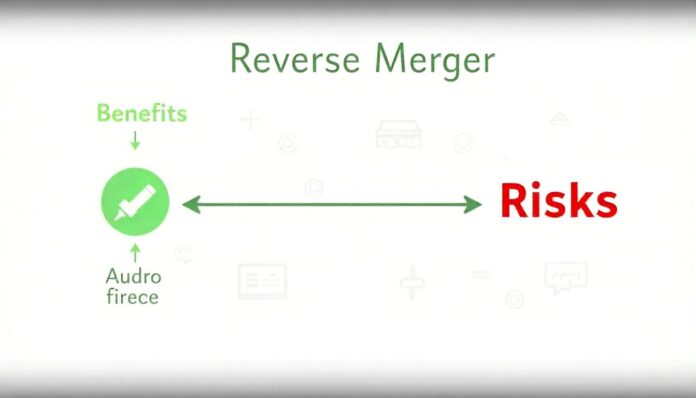The world of finance is full of twists and turns, but few strategies are as intriguing as the reverse merger process. If you’ve ever wondered how private companies can bypass the lengthy and often costly road to an IPO, you’re not alone. A reverse merger offers a unique opportunity for these companies to go public by merging with an already listed entity. This route has gained traction in recent years, presenting both enticing benefits and significant risks.
As more businesses seek innovative ways to access capital markets quickly, understanding the nuances of this process becomes essential. Whether you’re an investor curious about new opportunities or a business owner exploring growth avenues, diving into the mechanics of reverse mergers will illuminate why they are making headlines today. Let’s peel back the layers on this fascinating financial strategy!
What is a Reverse Merger?
A reverse merger is a financial maneuver that allows a private company to become publicly traded without undergoing the traditional initial public offering (IPO) process.
In this arrangement, a private firm merges with an existing public company, often one that has minimal operational activities or assets. Through this strategic union, the private entity can effectively “reverse” into the public market.
This method provides quicker access to capital and greater visibility for the business. It bypasses many of the stringent regulations and lengthy timelines associated with conventional IPOs.
The result? The private company gains immediate public status while allowing shareholders of the public entity to retain their investment. For many entrepreneurs seeking growth opportunities, it’s an attractive alternative worth exploring in today’s fast-paced business environment.
The Process of a Reverse Merger
The reverse merger process involves a private company acquiring a public one, allowing it to bypass the traditional IPO route.
Initially, the private entity seeks out an existing publicly traded shell company. This shell typically has minimal operations and assets but carries an established stock market presence.
Next comes due diligence. Both parties review financials and legalities to ensure compatibility. Once satisfied, they negotiate terms for the merger.
After signing agreements, shareholders of the private company often exchange their shares for those in the public entity. The transaction must then receive necessary regulatory approvals.
Post-merger, branding transitions occur as the former private firm becomes visible on stock exchanges under its new name or ticker symbol. Management structures may also shift to reflect this new ownership dynamic while aiming for growth and investor interest moving forward.
Benefits of a Reverse Merger
One of the most significant benefits of a reverse merger is the accelerated path to public company status. Traditional IPOs can take months, if not years, involving extensive regulatory hurdles and market volatility. In contrast, a reverse merger often requires less time and fewer resources.
Another advantage lies in achieving immediate access to capital markets. Companies that complete a reverse merger can tap into funds more quickly than through conventional routes.
Additionally, this process allows for greater flexibility in structuring deals. It opens up options for negotiation that might not be available through traditional methods.
Companies may also see enhanced credibility with customers and partners by being publicly traded. This newfound visibility can lead to increased trust and business opportunities in various sectors.
Risks Involved in a Reverse Merger
While reverse mergers can provide a fast track to public status, they come with significant risks. One major concern is the potential for inadequate due diligence. Acquiring a private company means inheriting its financial history and liabilities without complete transparency.
Another risk lies in market perception. Investors may view the newly merged entity skeptically, leading to volatility in stock prices. If the merger lacks solid fundamentals or clear growth strategies, it could deter investor confidence.
Moreover, regulatory scrutiny can be intense post-merger. Compliance issues may arise if proper procedures aren’t followed during integration, which might result in legal complications down the line.
Cultural mismatches between organizations also pose challenges. Differences in management styles and corporate cultures can hinder operational efficiency and employee morale after merging two distinct entities into one cohesive unit.
Case Studies: Successful and Failed Reverse Mergers
The world of reverse mergers has its share of success stories and cautionary tales. One notable success is the case of BurgerFi, which merged with a public shell company in 2018. This strategic move allowed them to access capital markets quickly, facilitating rapid expansion.
On the flip side, we have the story of China MediaExpress Holdings. Once a shining star in the sector, this company faced significant scrutiny after allegations surfaced regarding financial misrepresentation following its reverse merger. The fallout led to delisting from NASDAQ and ultimately bankruptcy.
These examples underscore that while reverse mergers can offer quick access to public funding, they come with inherent risks. A thorough due diligence process is crucial for companies considering this path, as evidenced by both triumphs and failures in the industry.
Alternatives to a Reverse Merger
When considering alternatives to a reverse merger, companies often look at traditional IPOs. An initial public offering can provide comprehensive access to capital markets and establish a clear valuation.
Another option is private equity financing. This route allows businesses to secure funds without the regulatory scrutiny that comes with going public.
Strategic partnerships also present an attractive alternative. Collaborating with established firms can open doors to new resources and market opportunities while minimizing risks associated with a standalone launch.
Additionally, crowdfunding has gained popularity in recent years. Platforms enable startups to raise funds directly from individual investors, providing flexibility without the complexities of mergers or acquisitions.
Venture capital funding remains a viable choice for many emerging companies seeking rapid growth and guidance from seasoned investors who can navigate industry challenges effectively.
Conclusion
The reverse merger process offers a unique route for companies looking to enter the public market. It allows private entities to bypass some of the complexities associated with traditional IPOs. However, it’s essential to weigh both benefits and risks carefully.
Successful examples demonstrate that when executed properly, reverse mergers can lead to substantial growth and visibility for emerging businesses. On the other hand, failures serve as cautionary tales about due diligence and operational challenges.
Alternatives like direct listings or SPAC mergers present different pathways with their own sets of considerations. Each option comes down to what aligns best with a company’s goals and resources.
Navigating these decisions requires careful thought, strategic planning, and an understanding of market dynamics. Whether you’re considering a reverse merger or exploring other avenues, being informed is key to making choices that will propel your business forward.













